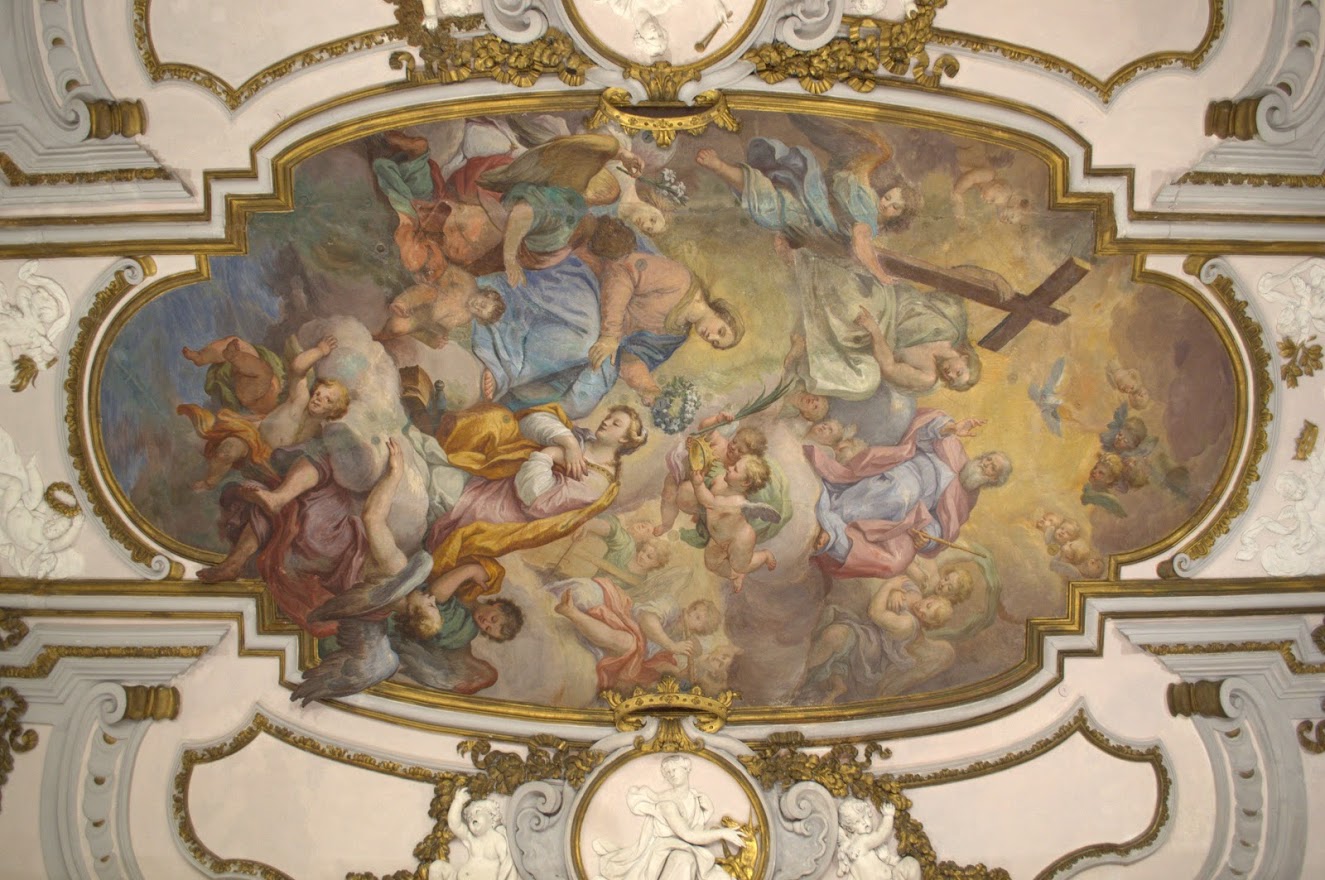
Read English version
L’interno dell’oratorio è un capolavoro realizzato in stucco e attribuito a Procopio Serpotta e Domenico Castelli.
Da ott a Pasqua (Oct to Easter): sab e dom (Fri. Sat. e Sun.) h 9.30am/1.00pm – 2.30pm/6.00pm .
Da dopo Pasqua a sett (Easter to Sept): sab e dom (Fri, Sat e Sun.) h 10.00am/1.30pm – 3.30 pm/7.00pm
Ordine Equestre del Santo Sepolcro di Gerusalemme
Sito web: www.santosepolcro.sicilia.it e-mail: info@santosepolcrosicilia.it
It was built around 1638 by the Company of Saint Catheine of Alexandria, founded in 1593.
Since 1946, the meetings and reserved celebrations of the Equestrian Order of the Holy Sepulcher have been held there.
The interior of the oratory is a masterpiece made of stucco and attributed to Procopio Serpotta and Domenico Castelli.
Once through the entrance, a series of allegorical statues, which enrich the side walls and the entrance wall, greet the gaze of the visitor, amazed by the beauty of the liturgical space.
These stucco works are by Procopio Serpotta (son of the great Giacomo) who, for the decoration of the oratory, was inspired by the tradition according to which Saint Caterina is considered the “Patroness of Culture”.
These allegorical figures, mainly female ones, symbolize Philosophy, Physics, Geometry, Theology, Rhetoric, Ethics, Geography, Astrology, Science and Wisdom.
Next to the triumphal arch, which separates the nave from the presbytery, there are the statues of the Virgin Saints of Palermo, Saint Ninfa and Saint Oliva, and in the apse, close to the painting of the main altar depicting “The Martyrdom of Saint Catherine” (1609) by Giuseppe Salerno, known as Zoppo di Ganci, there are the Virgins Saint Agata and Saint Rosalia. Each window of the oratory has a tympanum enriched by cherubs holding plaques and medallions.
The Oratory is also full of pictorial works of great importance. In addition to the aforementioned painting of the high altar, in the entrance wall opposite the high altar, there is a painting depicting the “Madonna and Child” (sixteenth century) by Vincenzo degli Azzani from Pavia. On the side walls there is a canvas with “Santa Caterina disputing with the wise men” on the left and on the right, another depicting “Santa Caterina in prison receiving the visit of the Empress”, wife of the Eastern Roman Emperor Maxentius.
The large chapel (the apse) was frescoed by Antonio and Paolo Grano with the “Triumph of Santa Caterina”.
In the entrance vestibule there is the mystical “Marriage of St. Catherine”, the painting by Giuseppe Salerno ( Zoppo di Gangi).
The wooden benches of the confrati, the companions, are in neoclassical style. They are aligned with the side walls and are enriched in an enchanting way by fourteen elliptical tables painted on the back that tell the life story of Saint Catherine V. M.
From the right wall towards the presbytery one can see: the Meeting between the Empress and the Saint; the Conversion of Porphyry, the Baptism of Porphyry, the Convocation of the Saint before the Emperor Maxentius and the Rhetoricians and Philosophers, the Vision of the Saint in prison, the Offer of wealth from the Emperor to the Saint to renounce her belief ( her finger toward the sky with which Catherine indicates the true Good is God), Saint Catherine and her acolytes opposing the pagan sacrifice before the Emperor. Continuing on the left, from the vestibule, one can see: Saint Catherine preaching among the soldiers, Saint Catherine in prison fed by a dove, the Torment of the wheel, the beheading of the Saint with the angels escorting her soul to heaven, transport of the body of Saint Catherine to Mount Sinai by the angels.
A superior mahogany bench, gilded and inlaid with ivory and mother of pearl from the second quarter of the eighteenth century, was reserved for the superior and the members.
In 1730, the marble masters Gioacchino and Nicolò Vitagliano created a magnificent polychrome marble floor with geometric figures and is like a carpet with an eight-pointed star in the centre, similar to that of other more famous Palermo Oratories.
Visits: closed. When it reopens it will follow the following timetable:
Oct to Easter: Fri. Sat. e Sun. h 9.30am/1.00pm – 2.30pm/6.00pm .
Easter to Sept:Fri, Sat e Sun. h 10.00am/1.30pm – 3.30 pm/7.00pm
For more information www.santosepolcrosicilia.it
Life of Saint Catherine V.M.
Saint Catherine, a Christian noblewoman, was martyred, according to tradition, in 305 A.D. in Alexandria, Egypt. Her martyrdom dates back to the time of Emperor Maxentius, who harshly persecuted the Christians. The Emperor, impressed by the firmness of Catherine who refused to offer Pagan sacrifices to the gods, summoned his rhetoricians and philosophers to convince her to offer sacrifices to the gods. Instead, it was Catherine who converted the philosophers and rhetoricians who were later burned alive as Christians.
The Emperor therefore tried to convince her by offering wealth and illustrious marriages but nothing was worth rejecting the True Faith in Christ.
Even the Empress tried to convince her but she was converted in turn and was martyred together with her followers who had become Christians. Then the virgin Catherine was put in prison where a dove was sent from above to feed her and when Jesus Christ used to visit her.
She was tried and sentenced to the spiked Wheel but the wheel broke thanks to divine intervention. Then she was beheaded and, according to the legend, a large quantity of milk- like substance flowed from her neck, immediately afterward the angels carried her to Mount Sinai where they buried her. The Martyrdom with the Wheel and the Coronation in the glory of heaven are the most represented episodes of the Saints life along with the so-called “Mystical Wedding of Saint Catherine”, which was celebrated during the night before her baptism, when Catherine had the vision of the Virgin introducing the Child Jesus to her.
Among her iconographic attributes are the spiked Wheel, the Palm of the martyr and the Book of the erudite woman…
